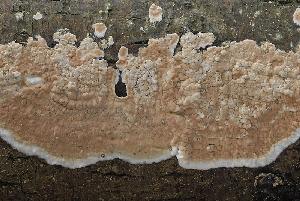
This genome was sequenced as a part of the large-scale multi-genome JGI CSP Saprotrophic Agaricomycotina Project (SAP), which focuses on the diversity and evolution of decay mechanisms, organismal phylogenetic relationships, and developmental evolution. A large collaborative effort led by PI of this project, David Hibbett (Clark University) aims for master publication(s) of the SAP data analysis.
The genus Cylindrobasidium belongs to the
Physalacriaceae family of the Agaricales. This family includes the
well-known pathogen Armillaria mellea (honey mushroom).
Unlike that species, however, Cylindrobasidium has a
simple, crust-like fruiting body, covering the surface of woody
substrate. This so-called resupinate fruiting body type is believed
to be ancestral in the Agaricomycetes, independently giving rise to
more complex morphologies. Because Cylindrobasidium is
closely related to Armillaria, for which a genome sequence
is also being produced, this pair of species will provide us with
an excellent resource to study the genomic changes underlying
changes in complexity level in mushroom fruiting bodies.
Understanding the genetic bases of fruiting body evolution in the
Agaricomycetes may directly contribute to the improvement of
commercial mushroom production. The Cylindrobasidium
genome. Together with that of Armillaria, will also
contribute to understanding of the genetic bases of switches
between decayer and timber pathogen lifestyles.
In addition to fruiting body evolution, the genome sequence of
Cylindrobasidium will contribute to understanding the
phylogenetic relationships in the Agaricales. Based on previous
multi-gene phylogenetic analyses, many of the interfamilial
relationships have proven difficult to resolve. This will be
greatly facilitated by phylogenomic analyses including
Cylindrobasidium.
Genome Reference(s)
Floudas D, Held BW, Riley R, Nagy LG, Koehler G, Ransdell AS, Younus H, Chow J, Chiniquy J, Lipzen A, Tritt A, Sun H, Haridas S, LaButti K, Ohm RA, Kües U, Blanchette RA, Grigoriev IV, Minto RE, Hibbett DS
Evolution of novel wood decay mechanisms in Agaricales revealed by the genome sequences of Fistulina hepatica and Cylindrobasidium torrendii.
Fungal Genet Biol. 2015 Mar;76():78-92. doi: 10.1016/j.fgb.2015.02.002
